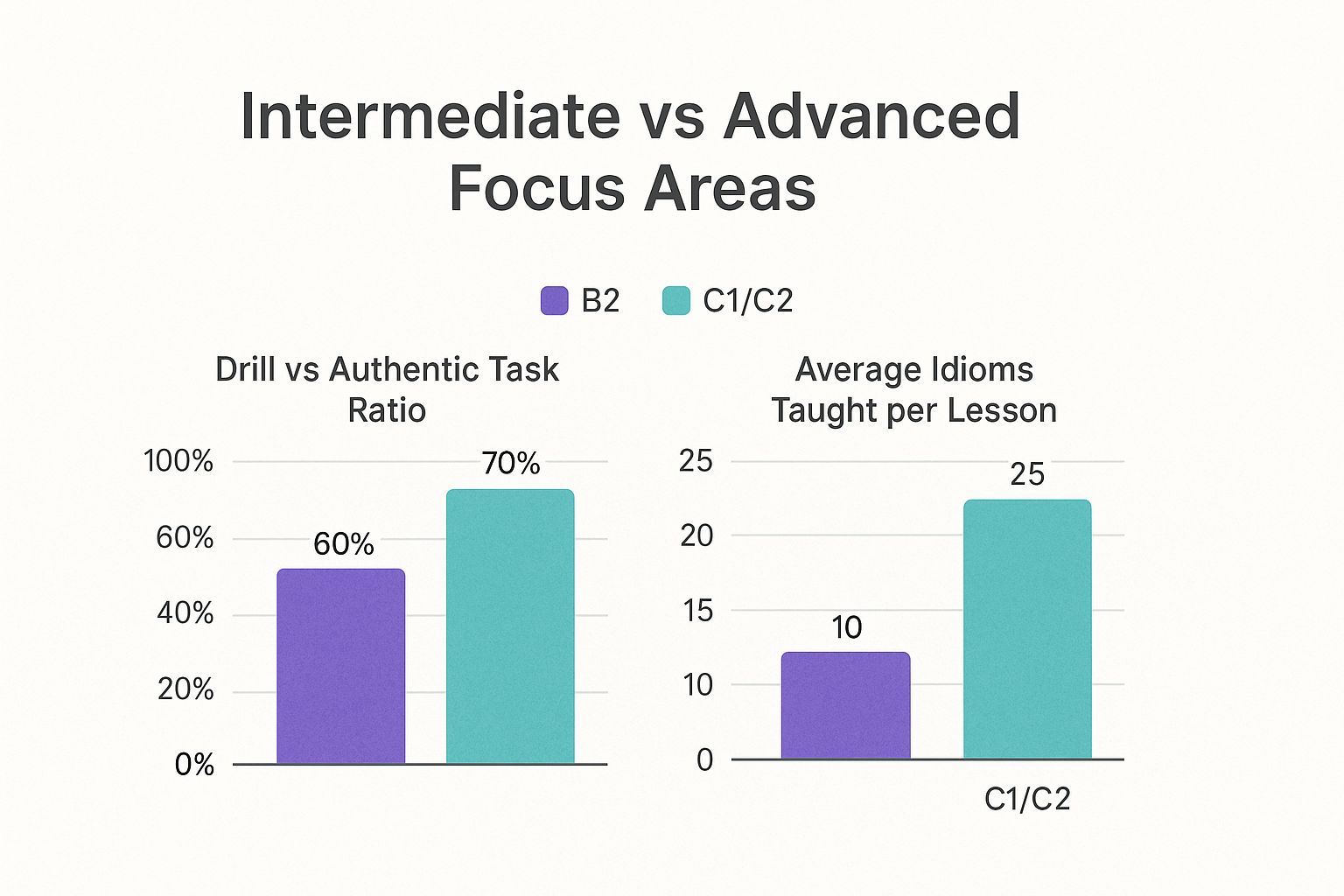How to Create an Advanced English Lesson That Engages
Unlock student potential with an advanced english lesson guide on planning engaging topics, dynamic activities, nuanced feedback, and AI-powered practice.


When we talk about an advanced English lesson, we’re moving far beyond simple grammar drills. The focus shifts to tackling the real-world challenges of communication: analyzing nuanced language, mastering idioms, and picking up on cultural subtext. It’s all about swapping out repetitive exercises for authentic tasks that build genuine linguistic sophistication and, most importantly, confidence.
Laying The Foundation for an Advanced English Lesson
Helping a student make the leap from intermediate to advanced English isn't just about teaching more vocabulary. It requires a complete rethink of how we design our lessons. The goal is no longer just grammatical accuracy; it's about fostering linguistic agility and a much deeper level of comprehension. This means we have to ditch the predictable fill-in-the-blank worksheets and start creating tasks that mirror the messy, complex reality of using English in the wild.
Think about it this way: an intermediate learner might practice verb tenses by completing a worksheet. An advanced learner, on the other hand, should be digging into a business meeting transcript to figure out how and why different tenses are used to signal certainty, politeness, or even strategic ambiguity. The focus moves from what is said to the subtle intentions behind it.
This shift is so important because most English conversations today happen between non-native speakers. English is a global behemoth with over 1.5 billion speakers, yet only around 380 million are native. In fact, some data suggests as few as 4% of English conversations worldwide involve two native speakers. It's the non-native speakers who are truly driving the language's evolution, which is a fascinating insight you can explore further in these English proficiency rankings.
Shifting from B2 to C1/C2 Focus
To build a lesson that truly challenges an advanced student, you need to set "stretch goals" that gently push them out of their comfort zone. This isn't about making them feel overwhelmed. It's about creating a safe space where they feel comfortable experimenting with language and see mistakes as learning opportunities, not failures.
A huge part of this is rebalancing your lesson activities. Drills can still be useful for reinforcement, but the main event needs to be authentic tasks that demand critical thinking and spontaneous language use.
Here’s a snapshot of how the priorities change when you're planning for a C1/C2 student versus a B1/B2.

As you can see, advanced lessons lean heavily into real-world tasks and significantly ramp up the exposure to idiomatic language. This is what prepares learners for the rhythms and quirks of natural, everyday conversation.
To make this crystal clear, let's break down the key differences in a table.
Key Focus Areas for an Advanced English Lesson
This table shows exactly where you need to deepen your focus when moving students from an intermediate to an advanced level.
| Component | Intermediate Focus (B1/B2) | Advanced Focus (C1/C2) |
|---|---|---|
| Vocabulary | General topics, common phrasal verbs. | Nuanced synonyms, collocations, idiomatic expressions, register-specific jargon. |
| Grammar | Reviewing and solidifying complex tenses (e.g., perfect continuous). | Mastering subtle grammatical structures (e.g., inversion, cleft sentences) for emphasis and style. |
| Activities | Controlled practice, role-plays with clear prompts, structured debates. | Authentic tasks, spontaneous debates on complex topics, case study analysis, persuasive presentations. |
| Comprehension | Understanding the main ideas and explicit details in a text or audio. | Inferring meaning, recognizing tone, identifying bias, understanding cultural subtext and sarcasm. |
| Error Correction | Focusing on major grammatical errors that impede communication. | Focusing on errors related to naturalness, style, word choice, and subtle inaccuracies (fossilized errors). |
Essentially, the goal shifts from just being understood to communicating with precision, sophistication, and flair.
Creating a Supportive Learning Atmosphere
Getting the classroom vibe right is just as crucial as the content you teach. Advanced learners often hit a frustrating confidence plateau—they know a lot of grammar and vocabulary but feel stuck. To break through this barrier, you have to encourage them to take risks, like trying out a new idiom or attempting a complex sentence.
Here are a few practical ways I’ve found to build that supportive atmosphere:
- Frame errors as discoveries: When a student makes a mistake, don't just correct it. Turn it into a teachable moment. Say something like, "That's an interesting way to phrase it. Let's talk about why a native speaker might say it this way instead..."
- Encourage peer feedback: Set up structured activities where students can offer constructive feedback to one another. Give them specific things to listen for so the feedback is helpful, not just generic.
- Celebrate the effort, not just the outcome: Make a point to praise a student for trying a challenging phrase, even if it doesn't come out perfectly. A simple "Great attempt with that new expression!" can work wonders for their confidence.
When you pair ambitious learning goals with a psychologically safe environment, you create the perfect conditions for advanced students to finally achieve the fluency and confidence they're working so hard for.
How to Choose Topics That Actually Challenge Advanced English Learners

Let’s be honest: "My favorite hobby" just won't fly in an advanced English lesson. Once your students reach this level, the real challenge isn't just getting them to talk, but getting them to think deeply and articulate complex ideas. We need topics that spark genuine intellectual curiosity.
The magic happens when the topic itself demands sophisticated language. Instead of drilling a specific grammar point, you can pick a theme where it shows up naturally. For example, a debate on the ethical tightrope of AI will organically pull out hypothetical structures, persuasive language, and specialized vocabulary.
This push for higher proficiency is a huge deal. The global English learning market is set to grow by a staggering $14.37 billion between 2022 and 2026, largely because the professional world demands more than just basic conversation skills. You can dig into these market trends on ecenglish.com.
Go Beyond the Textbook: Find Authentic, Complex Materials
The best lesson material comes from the real world, not a watered-down textbook passage. Authentic content throws learners right into the mix of how English is actually used—complete with all its idioms, cultural quirks, and natural rhythms. This is where the real growth happens.
To find content that will truly resonate, you have to look in the right places. I've had the most success with sources like these:
- Opinion Pieces & Editorials: Publications like The New York Times or The Guardian are gold mines for well-structured arguments and persuasive language that are perfect for deconstruction.
- Academic Journals (Stick to the Intro): You don't need the whole paper. The introduction or abstract of a journal article presents a complex idea in a dense, formal style that's fantastic for close analysis.
- Podcasts & Documentaries: These are brilliant for exposing students to authentic spoken English, complete with different accents, unscripted moments, and overlapping speakers.
The secret is to pick content that presents a problem, a debate, or a nuanced perspective. A little ambiguity is a good thing! It pushes learners to analyze, infer, and form their own complex thoughts instead of just spitting back facts.
Make It Relevant: Tailor Topics to Your Students
Even the most fascinating topic will fall flat if it doesn't connect with your learners. I use a quick mental filter before committing to a theme: Does this link to their professional goals, academic pursuits, or personal passions?
A lesson analyzing a political speech might be a hit with students studying international relations, but it could bore a group of software engineers. For them, a deep dive into a tech product launch or a debate on data privacy policies would be way more engaging.
When you align topics with their world, every advanced English lesson feels immediately useful and worth their time.
Looking for more specific ideas to get the ball rolling? Check out our guide on conversation topics for adults for some great starting points.
Design Activities That Foster Advanced English Fluency

An advanced English lesson truly comes alive with activities that don't just practice the language—they demand it. The secret is designing tasks where sophisticated English becomes a necessary tool for success, not just the end goal itself.
Let's move past the basic "At the restaurant" role-plays. We need to throw our students into dynamic, high-stakes scenarios. Imagine setting up a mock negotiation where students, acting as different department heads, must argue for their slice of a limited company budget. Suddenly, they aren't just reciting vocabulary; they're deploying persuasive language, using conditional clauses for compromise, and finding just the right nuance to defend their position. This is where real fluency starts to emerge.
Moving from Role-Play to Reality Simulation
For advanced learners, the leap from a scripted role-play to a more fluid reality simulation is a game-changer. Simple scripts get tossed aside for scenarios with clear goals but messy, unpredictable paths. This forces students to think on their feet and adapt their language in the moment.
Here are a few reality simulations that get fantastic results:
- Collaborative Problem-Solving: Give a group a complex, real-world issue, like developing a sustainability plan for a local business. They’ll have to research, debate solutions, and pull together a joint proposal.
- Persuasive Pitch Presentations: Task students with creating and pitching a new product to a panel of "investors" (their classmates). This really sharpens their ability to build a compelling argument.
- Crisis Management Scenarios: Drop a fictional PR crisis in their laps. Teams have to draft press releases, role-play tense press conferences, and manage internal communications, all with the clock ticking.
These kinds of activities push learners way beyond their comfort zones. They have to dig deep and use every linguistic tool they have to get a tangible result.
Structuring Debates for Maximum Impact
Formal debates are a classic for a reason—they're brilliant for practicing structured arguments and sophisticated rhetorical devices. But just throwing a topic out there isn't enough. I've found that a well-structured debate, built in stages, makes all the difference.
Here’s a simple sequence I swear by:
- The Prep Phase: Students research their side, dig up evidence, and craft opening statements. This is their chance to consciously plan on weaving in specific grammatical structures or idioms they want to master.
- The Performance: This is the debate itself. To really turn up the heat, I like to introduce a "devil's advocate" role that rotates, forcing everyone to counter unexpected points.
- Reflection and Feedback: Afterward, we debrief. What worked? Where did they get stuck finding the right words? Getting feedback from their peers at this stage is pure gold.
By sequencing the activity this way, you transform a simple speaking task into a full learning cycle: preparation, application, and analysis. This builds not only speaking skills but also critical thinking and self-awareness.
This kind of active, hands-on engagement is what makes learning stick. If you're looking for more ways to create these kinds of interactive moments, our guide on English conversation practice online has some great strategies you can adapt.
At the end of the day, the best activities are the ones that make students forget they're "learning English." They're too busy trying to win a debate, solve a problem, or close the deal.
Master Nuanced Error Correction in Advanced English Lessons

When you're teaching advanced English, the question isn't if you should correct an error, but how and when. Jump on every little mistake, and you’ll kill a student's confidence and conversational flow. Our real goal is to give feedback that builds them up, not makes them scared to open their mouths.
This is where you have to get strategic. It’s all about subtle, well-timed corrections. You learn to pick your battles. Is a student consistently fumbling the subjunctive mood? Yeah, that’s something to work on. Did they use the wrong preposition once in an otherwise great sentence? I've learned it's usually best to let that slide to keep the conversation moving.
Adopt Delayed Correction and Recasting
One of my go-to methods is delayed correction. It’s simple but incredibly effective. While a student is speaking, I’ll just quietly jot down any significant errors on a notepad. Then, once the activity is over, we can take a few minutes for a focused review. This creates a "correction pocket" that doesn't break the natural rhythm of the discussion.
Another fantastic technique is recasting. This is where you subtly rephrase what the student said, but with the correct grammar. It’s a very gentle touch.
- Student: "I wish I was there with you."
- You (recasting): "Ah, you wish you were there. It sounds like a fantastic trip!"
You're giving them the correct model without explicitly saying, "You made a mistake." The student absorbs the right structure almost by osmosis, and the conversation keeps going. It’s a nudge, not a hard stop.
Remember, at this level, mistakes are not signs of failure; they are signs of learning and experimentation. Your correction style should reflect this by encouraging risk-taking, not punishing imperfection.
Empower Learners with Self-Correction Tools
Ultimately, we want our students to catch their own mistakes. Building that kind of linguistic awareness is a game-changer. The faster they can spot their own errors, the faster they’ll improve.
A couple of ways I like to build this skill are through peer review and self-correction exercises.
- Peer-Review Checklists: After a speaking task, I'll pair students up and give them a simple checklist. I might ask them to listen for just one or two things, like the correct use of past modals or whether their partner used varied vocabulary. This gets them listening critically and offering helpful feedback.
- Self-Correction Prompts: I give my students a running list of their own common error patterns. After they finish a speaking activity (especially one they can record), I give them a moment to listen back and hunt for those specific mistakes themselves.
This screenshot from the TalkEasy platform, for instance, shows how AI can offer that instant, private feedback. It lets learners practice and self-correct on their own time, without the pressure of a live audience. Bringing tools like this into the mix helps build the self-awareness they need to improve independently, which in turn frees up our class time for more dynamic and interactive work.
Weaving AI Tools Into Your Advanced English Lesson
Let’s be honest: giving every advanced student enough speaking time in a group setting is a huge challenge. This is where technology can genuinely make a difference, especially when it comes to building confidence for those high-stakes conversations.
Think of an AI tool like TalkEasy as a tireless, on-demand conversation partner. It’s available 24/7, offering a safe, judgment-free zone where students can experiment with complex language without the pressure of a live audience.
By handing over the repetitive drilling to AI, you free up valuable class time. Instead of just running through basic role-plays, you can focus on what you do best: facilitating nuanced group discussions, analyzing performance, and providing strategic, human-centered feedback.
Tailoring AI for Targeted Practice
The real magic of using an AI partner in your lesson plan is the ability to create bespoke practice scenarios. You can design conversations that directly mirror your learning objectives.
For example, if the week's topic is persuasive language, why not have students practice on an AI? You could set up a simulation of a tense stakeholder meeting where they have to pitch a new project and handle objections. It’s a way for them to move from theory to application in a dynamic, interactive way.
They can run the scenario over and over, tweaking their word choice, tone, and sentence structure until they feel they've nailed it.
Here are a few ideas to get you started:
- Realistic Job Interviews: Program the AI with tough, industry-specific interview questions. This lets students practice talking about their skills and experience with professional polish.
- Challenging Panel Discussions: Set up a conversation where the AI acts as a fellow panelist or moderator, pushing students to defend their arguments on complex issues.
- High-Pressure Media Training: Create a mock press conference. The AI "journalist" can ask difficult questions, forcing students to think on their feet and use diplomatic language.
The aim here is to build authentic, repeatable challenges. When students can practice in a low-stakes environment, they make bigger breakthroughs in confidence and fluency. Mistakes aren't embarrassing—they’re just data points for the next attempt.
Using AI Transcripts for Laser-Focused Feedback
One of the best features of AI conversation tools is the instant transcript. After a session on a platform like TalkEasy, you get a complete record of the entire conversation. This is an absolute goldmine for giving feedback.
No more relying on memory or scribbled notes. You and your student can sit down with a concrete record of what was said.
You can even teach them how to analyze their own transcripts. Guide them to spot where they hesitated with a new idiom or struggled with a specific grammar point. This self-review process builds incredible self-awareness and helps them take real ownership of their learning.
For instance, if a student reviews a transcript and hears that their intonation sounds flat, that's a perfect, self-identified reason to explore how to learn an English accent with a clear goal in mind.
This creates a powerful learning loop: students get the high-volume speaking practice they desperately need from the AI, and you provide the expert insights that make that practice count.
Traditional vs. AI-Powered Practice Activities
To see the difference clearly, let's compare how common practice activities change when you introduce an AI tool into the mix.
| Activity | Traditional Method | AI-Enhanced Method (with TalkEasy) |
|---|---|---|
| Debate Practice | Students debate in pairs; teacher observes and gives delayed feedback. Limited speaking time per student. | Each student debates one-on-one with an AI on a specific topic. They get unlimited speaking time and instant feedback on language use. |
| Presentation Rehearsal | Students practice in front of a mirror or record themselves. Feedback is based on self-assessment. | Students deliver their presentation to an AI that can ask clarifying questions. They receive a full transcript and analysis of filler words. |
| Negotiation Role-Play | Paired role-play in class, often with uneven partner skill levels. Teacher can only monitor one pair at a time. | Students negotiate with a customizable AI persona (e.g., "difficult client"). The scenario is consistent and repeatable for mastery. |
| Accent & Pronunciation | Teacher models pronunciation; students repeat. Drills can be repetitive and not always context-based. | AI provides immediate, phoneme-level feedback. Students can practice specific words or phrases in the context of a real conversation. |
This comparison highlights how AI doesn't replace the teacher but rather supercharges the student's independent practice time, allowing for deeper, more personalized learning.
Got Questions About Teaching Advanced English? We've Got Answers.
When you're guiding learners who are already pretty good at English, the challenges change. The big, obvious grammar hurdles are mostly behind them. Now, it’s all about the subtle stuff—the fine-tuning that separates a proficient speaker from a truly fluent one. Let's tackle some of the most common questions that pop up when you're crafting lessons for these high-level students.
How Do You Juggle Fluency and Accuracy?
Ah, the age-old dilemma. Push for perfect grammar, and you might kill the conversational flow. Let them talk freely, and fossilized errors can become permanent. The secret isn't to choose one over the other; it's to give each its own time to shine.
Think of your lesson in two distinct phases. First, a "fluency-focused" block. This is where you throw them into the deep end with a fast-paced debate or an unscripted role-play. The goal here is pure communication. Let them get their ideas out, stumbles and all. While they're talking, don't interrupt. Instead, be a quiet observer, jotting down notes on recurring errors or awkward phrases to revisit later.
Then, you shift gears into an "accuracy-focused" phase. This is your chance to zoom in. You could pull up a transcript from the role-play and dissect a few key sentences, or work through a targeted exercise on, say, using inversions for emphasis. By creating this separation, you give students the freedom to speak confidently without fear of constant correction, but you also provide the targeted feedback they need to actually get better.
The rule I always follow is this: if the point is to express an idea, fluency wins. If the point is to perfect how that idea is expressed, it's accuracy's turn.
How Can You Actually See Progress at a C1/C2 Level?
Let's be honest, progress at this level is subtle. You won't see the dramatic leaps and bounds of a beginner. So, forget about tracking the number of new vocabulary words learned. Instead, you need to look for the smaller, more nuanced signs of growth. I like to use a simple progress-monitoring chart to keep track of qualitative shifts.
Here are a few things I always look for:
- Lexical Sophistication: Are they moving beyond "good" and "bad" to use more precise words like "superb" or "detrimental"? I make a note of specific examples when I hear them.
- Idiomatic Language: Are they weaving in collocations and idioms naturally, or does it sound forced? I might even tally how many they use correctly in a session.
- Discourse Management: How well are they building an argument? Can they transition smoothly from one point to the next? I'll often rate their coherence on a simple 1-5 scale after a discussion.
- Error Self-Correction: This is a huge one. How often do they catch their own mistakes mid-sentence and fix them? That’s a massive sign that their internal grammar monitor is getting sharper.
Where Do You Find Good Authentic Materials for This Level?
Finding content that's genuinely challenging without being totally demoralizing is half the battle in an advanced English lesson. It’s time to look past the usual news websites.
Your students need to be exposed to real, complex, and sometimes messy language. Here are a few of my go-to sources:
- University Lectures: Sites like Coursera or edX are goldmines. Many offer free introductory lectures, often with full transcripts, on every topic imaginable.
- Industry-Specific Podcasts: Is your student an engineer? A marketer? Find a podcast for professionals in their field. The specialized jargon and natural conversations are invaluable.
- Documentary Films: Documentaries are fantastic. They expose students to a variety of accents, speaking speeds, and complex ideas, all wrapped in a compelling story.
- Literary Journals & Essays: For students who need to refine their writing or appreciate stylistic flair, nothing beats a well-written essay from a literary journal. The language is rich and intentionally crafted.
How Do You Use AI Tools Without Making Lessons Feel Robotic?
AI conversation partners can be an incredible asset, but they can't replace you. The key is to blend their strengths with your expertise. Think of AI as the tireless sparring partner and you as the strategic coach.
Use the AI for the high-volume "reps." Have students use it at home to practice a presentation 5 times or run through mock interview questions until they feel comfortable. This is something you simply don't have time for in class, and it frees you up to focus on what humans do best.
Then, when they come to your session, you can do the high-value work. You can analyze the AI-generated transcripts together, discuss the nuances of their word choices, and run group role-plays where they apply what they practiced. The AI provides the practice; you provide the insight and the human connection.
Ready to give your students the unlimited, on-demand speaking practice they need? TalkEasy offers a powerful AI conversation partner that can simulate real-world scenarios, provide instant feedback, and help learners build unshakable confidence. Discover how TalkEasy can supercharge your advanced English lessons.